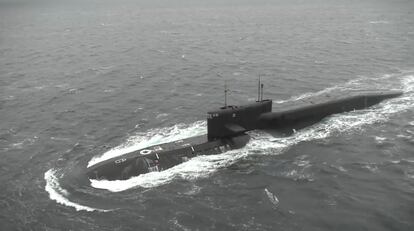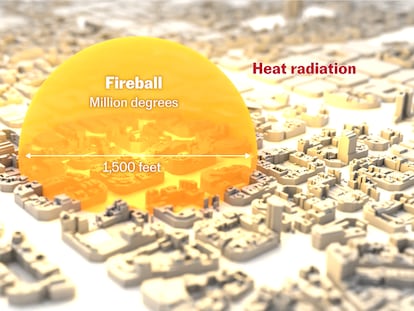Russian Navy takes delivery of ‘weapon of the apocalypse’ as Putin delivers on strategic threat
Poseidon is one of the next generation arms announced by Moscow five years ago with the capacity to devastate coastal cities and attack naval battle groups undetected


The Russian Navy has taken delivery of the first nuclear submarine drones announced under Vladimir Putin’s strategic weapons program in March 2018. Tests on the Poseidon nuclear-powered unmanned underwater vehicle (UUV) have concluded, and the system will soon be deployed on one of Moscow’s new-generation submarines, according to Russian media reports. In the context of the Kremlin’s invasion of Ukraine, NATO has expressed its concern over Poseidon, which is capable of delivering both nuclear and conventional warheads, triggering tsunamis and contaminating vast expanses of water with radioactive materials.
“Russia still has the greatest nuclear potential in the world, but nobody listened to us,” Putin said in his speech to the federal assembly almost five years ago. “Listen now.” The Russian leader unveiled a raft of proposed new weapons systems, among them the then-unnamed Poseidon, which he noted would be “practically indestructible,” almost silent and capable of great maneuverability. Another of the arms announced by Putin has already been deployed in Ukraine: the Kinzhal hypersonic missile. Poseidon will represent another escalation of Russia’s nuclear threat against the West.
The Russian industrial military sector has tested the principal components of Poseidon, including its atomic motor, and the first models will be deployed on the Russian Navy’s Oscar-class nuclear submarine Belgorod “in the near future,” according to sources close to the project quoted by the TASS news agency.
Poseidon is essentially a drone capable of carrying a nuclear warhead over intercontinental distances while submerged at great depth and reaching faster speeds than a naval vessel or a conventional torpedo. In its nuclear torpedo variant, the Poseidon’s main objectives would be coastal cities and enemy battle groups. The systems feature stealth technology, making them extremely hard to detect.
According to reports in the Russian media when Poseidon was first presented, its payload was intended to be 100 megatons, twice as powerful as the biggest nuclear bomb in history, the Tsar. The former Soviet Union tested Tsar in the 1970s in a remote Arctic location, although TASS has since reduced its level of destruction to two megatons, which is still more powerful than the atomic bombs dropped on Hiroshima and Nagasaki in World War II.
Poseidon has been nicknamed “the weapon of the apocalypse” due to their destructive power. In November 2020, then-US assistant secretary of state for international security and non-proliferation Christopher Ford said that the arms had been designed to “inundate US coastal cities with radioactive tsunamis.” As such, US intelligence has stated that Poseidon could be used to withstand a hypothetical first nuclear strike against Russia to then hit back in a second or third wave of retaliatory attacks.
NATO believes that Moscow tested Poseidon without a nuclear payload in the Black Sea last autumn. However, at the moment only the Belgorod, which has been specifically modified for the purpose, is capable of carrying Poseidon torpedoes. At 180 meters, the Belgorod is the largest nuclear submarine in the world and entered into service in July, 2022. According to Italian newspaper La Repubblica, NATO issued an alert shortly afterward when it disappeared from radar amid escalating Kremlin rhetoric of a nuclear confrontation with the West. The Belgorod reappeared in the Arctic in October.
According to a report by the US Congressional Research Service, “Russia may deploy the Poseidon drone on four submarines, two in the Northern Fleet and two in the Pacific Fleet. Each submarine would carry eight drones.”
“Russia is pursuing several novel nuclear-capable systems designed to hold the US homeland or Allies and partners at risk, some of which are also not accountable under [nuclear arms reduction treaty] New START,” the Biden administration noted in its 2022 Nuclear Posture Review.
Last year, the US Naval Institute said Russia’s development of the Poseidon turned assumptions about submarine-launched nuclear weapons on their head. “Perhaps most frighteningly, this nuclear weapon has the potential for autonomous operation,” the institute said. “A fully operational Kanyon [the NATO designation assigned to Poseidon] would have an incredible strategic impact. As a new delivery platform, it is not covered by current nuclear weapons treaties.”
Sign up for our weekly newsletter to get more English-language news coverage from EL PAÍS USA Edition
Tu suscripción se está usando en otro dispositivo
¿Quieres añadir otro usuario a tu suscripción?
Si continúas leyendo en este dispositivo, no se podrá leer en el otro.
FlechaTu suscripción se está usando en otro dispositivo y solo puedes acceder a EL PAÍS desde un dispositivo a la vez.
Si quieres compartir tu cuenta, cambia tu suscripción a la modalidad Premium, así podrás añadir otro usuario. Cada uno accederá con su propia cuenta de email, lo que os permitirá personalizar vuestra experiencia en EL PAÍS.
¿Tienes una suscripción de empresa? Accede aquí para contratar más cuentas.
En el caso de no saber quién está usando tu cuenta, te recomendamos cambiar tu contraseña aquí.
Si decides continuar compartiendo tu cuenta, este mensaje se mostrará en tu dispositivo y en el de la otra persona que está usando tu cuenta de forma indefinida, afectando a tu experiencia de lectura. Puedes consultar aquí los términos y condiciones de la suscripción digital.
More information
Archived In
Últimas noticias
Welcome to the post-religion era: The idea of Christianity as the absolute truth has become obsolete
‘I thought you would like it’: The risky sexual practice popularized by TV shows and TikTok
The digitalization of tourism: ‘They promise experiences and gave us the worst possible one’
Mexican peso defies uncertainty with forecasts of a new period of stability in 2026
Most viewed
- Sinaloa Cartel war is taking its toll on Los Chapitos
- Oona Chaplin: ‘I told James Cameron that I was living in a treehouse and starting a permaculture project with a friend’
- Reinhard Genzel, Nobel laureate in physics: ‘One-minute videos will never give you the truth’
- Why the price of coffee has skyrocketed: from Brazilian plantations to specialty coffee houses
- Silver prices are going crazy: This is what’s fueling the rally










































